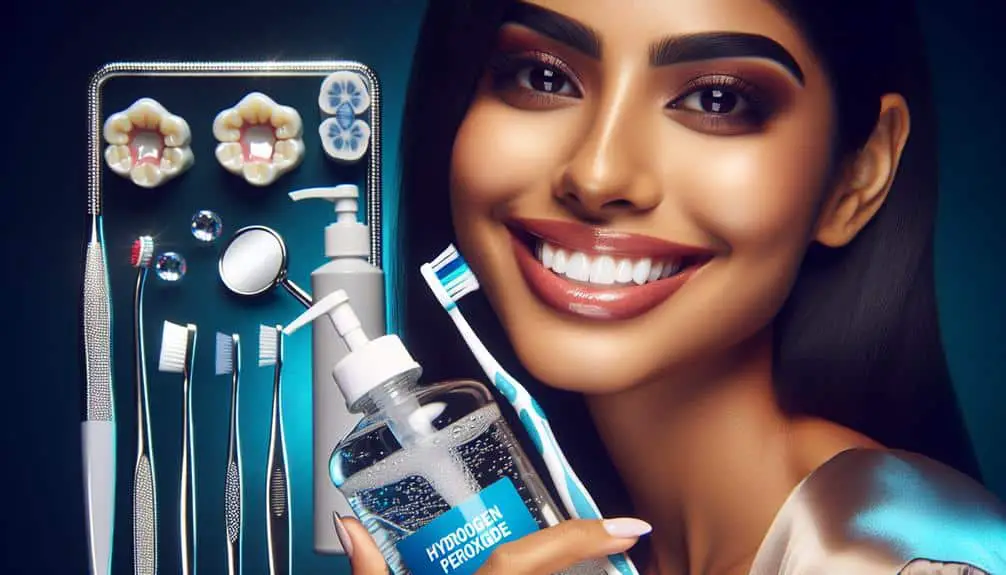To whiten your teeth effectively with hydrogen peroxide, consider these top methods: mix it with baking soda for a natural whitening alternative that is cost-effective and gentle on your enamel; use it as a mouthwash for antimicrobial benefits, but remember to dilute properly and consult with your dentist before regular use; create a DIY whitening paste by combining baking soda and food-grade hydrogen peroxide, using sparingly to avoid enamel damage; apply whitening gel thinly and evenly on each tooth, ensuring not to contact gums, for best results; follow strip application tips diligently for consistent results and better adhesion; and don't forget to brush trays gently after each use and store them properly for improved whitening over time.
These methods are safe and effective, providing you with a brighter smile and improved oral hygiene.
Key Points
- Start with lower hydrogen peroxide concentrations to prevent sensitivity.
- Mix with baking soda for a natural whitening alternative.
- Use as mouthwash for antibacterial benefits and oral hygiene.
- Create a DIY whitening paste with baking soda and hydrogen peroxide.
- Apply whitening gel evenly, avoid gum contact, and rinse thoroughly.
Hydrogen Peroxide Safety Precautions
To ensure safe and effective use of hydrogen peroxide for teeth whitening, it's essential to follow specific safety precautions. Initially, consider the peroxide concentration. Most over-the-counter solutions for teeth whitening contain hydrogen peroxide concentrations ranging from 3% to 10%. Higher concentrations can lead to increased tooth sensitivity and potential gum irritation. It's recommended to start with lower concentrations and gradually increase if needed, under professional guidance.
Moreover, the contact time plays a vital role in ensuring safety. Limit the exposure time of hydrogen peroxide to your teeth as per the product instructions. Extended contact can result in enamel damage and increased sensitivity. Thus, strictly adhere to the recommended time frames to prevent adverse effects.
Mixing Hydrogen Peroxide With Baking Soda
Consider enhancing the whitening effects by exploring the method of mixing hydrogen peroxide with baking soda for a potent teeth-whitening solution. Baking soda is known for its abrasiveness, which can help remove surface stains on teeth when combined with hydrogen peroxide. This combination creates a natural whitening alternative that can be effective in brightening your smile.
Baking soda's effectiveness lies in its mild abrasive properties, which can gently scrub away stains on the enamel without causing damage. When mixed with hydrogen peroxide, which acts as a bleaching agent, this duo can work together to break down stains and lighten the color of your teeth.
Incorporating baking soda into your teeth whitening routine offers a gentle yet efficient way to achieve a brighter smile. It provides a natural alternative to commercial whitening products and can be a cost-effective solution for those looking to improve the appearance of their teeth.
Using Hydrogen Peroxide as Mouthwash
When using hydrogen peroxide as mouthwash, you can benefit from its antibacterial properties that can help reduce plaque and gingivitis.
However, it's essential to dilute it properly to avoid irritation or damage to the tissues in your mouth.
Always follow safety precautions such as not swallowing the solution and rinsing your mouth thoroughly with water after use.
Benefits of Mouthwash
Using hydrogen peroxide as a mouthwash can provide effective benefits for oral hygiene and teeth whitening. Hydrogen peroxide has antimicrobial properties that can help reduce bacteria in the mouth, promoting healthier gums and fresher breath.
Additionally, it can assist in teeth whitening by breaking down stains on the enamel's surface. When used as a mouthwash in appropriate concentrations, hydrogen peroxide can be a cost-effective and convenient way to improve oral health and enhance the brightness of your smile.
However, it's important to use it in moderation to prevent any potential side effects and to consult with your dentist before incorporating it into your oral care routine to make sure it aligns with your specific needs.
Safety Precautions for Mouthwash
To ensure safe and effective use of hydrogen peroxide as a mouthwash, it's vital to follow specific safety precautions.
When using hydrogen peroxide as a mouthwash, dilute it with water to reduce its concentration and prevent irritation. It's important to avoid swallowing hydrogen peroxide, as it can cause stomach irritation and other adverse effects.
Additionally, be careful not to use hydrogen peroxide mouthwash too frequently, as it may lead to sensitivity or damage to the soft tissues in your mouth. Always consult with your dentist before incorporating hydrogen peroxide mouthwash into your oral care routine, especially if you have any existing oral health conditions.
DIY Hydrogen Peroxide Teeth Whitening Paste
Consider incorporating hydrogen peroxide into a homemade teeth whitening paste for a vital and efficient oral care routine. DIY teeth whitening pastes are popular due to their natural ingredients and potential effectiveness as home remedies.
To create a simple yet potent paste, mix 2 tablespoons of baking soda with 1 tablespoon of food-grade hydrogen peroxide. The baking soda acts as a mild abrasive that helps scrub away surface stains, while hydrogen peroxide functions as a bleaching agent to whiten teeth.
This mixture forms a paste that you can gently brush onto your teeth. Remember not to swallow the paste and thoroughly rinse your mouth after a minute of brushing. It's crucial to use food-grade hydrogen peroxide for oral purposes and not the stronger version used for hair or wound care.
While this DIY method can be effective, it's vital to use it sparingly to avoid damaging tooth enamel. Incorporate this paste into your oral care routine once a week for a natural teeth whitening boost.
Hydrogen Peroxide Whitening Gel Application
When applying hydrogen peroxide whitening gel to your teeth, make sure you cover each tooth evenly using a thin layer to avoid sensitivity.
Remember to follow the suggested duration for the gel to stay on your teeth to achieve best whitening results.
These techniques, coupled with proper duration tips, can help you achieve a brighter smile effectively.
Gel Application Technique
For best outcomes in hydrogen peroxide teeth whitening, ensure correct application of the whitening gel. When applying the gel, make sure to follow these best practices:
- Start by brushing and flossing your teeth to prep them for the gel application.
- Use a small amount of gel evenly on the front surface of each tooth, preventing it from touching your gums.
- Avoid swallowing the gel and leave it on for the recommended time.
- After use, rinse your mouth thoroughly.
To monitor results, take before and after photos to track progress effectively. Following the whitening session, maintain good oral hygiene practices, and consider aftercare recommendations like avoiding staining foods and drinks for a while. Mastering these techniques will help you achieve the most favorable whitening results.
Whitening Duration Tips
To maximize the effectiveness of hydrogen peroxide teeth whitening gel application, adhere to recommended whitening duration tips. When using hydrogen peroxide whitening gel, follow these essential guidelines for best results:
- Whitening Maintenance Tips: After completing a whitening treatment, maintain your results by avoiding foods and beverages that stain teeth, such as coffee and red wine.
- Whitening Frequency Suggestions: Consult with your dentist to determine the ideal frequency for whitening treatments based on your individual needs and the strength of the hydrogen peroxide gel used.
- Consistency is Key: Stick to a consistent whitening schedule to achieve and maintain a brighter smile without overdoing it, which could lead to tooth sensitivity.
Following these whitening duration tips will help you achieve a whiter smile effectively and safely.
Hydrogen Peroxide Whitening Strips Technique
Curiously exploring the effectiveness of the hydrogen peroxide whitening strips technique? Hydrogen peroxide whitening strips are a popular at-home teeth whitening method known for their importance and ease of use. These strips typically contain a lower concentration of hydrogen peroxide compared to professional treatments but can still effectively whiten teeth when used correctly.
When it comes to whitening strip effectiveness, results may vary depending on individual factors such as the starting shade of your teeth and adherence to the recommended usage guidelines. Generally, most users see noticeable improvements in the brightness of their teeth after a few applications.
To maximize the effectiveness of hydrogen peroxide whitening strips, it's vital to follow strip application tips carefully. Make sure your teeth are clean and dry before applying the strips to promote better adhesion and contact with the enamel. Additionally, be consistent with the application schedule as directed by the product instructions to achieve best results.
Hydrogen Peroxide Whitening Tray Instructions
Achieve best teeth whitening results with hydrogen peroxide whitening trays by following these step-by-step instructions.
To guarantee best whitening results and maintain the effectiveness of your hydrogen peroxide whitening trays, consider the following:
- Vital Tray Maintenance:
- Brush your trays gently after each use with a soft-bristled toothbrush.
- Rinse the trays thoroughly with cold water to remove any leftover hydrogen peroxide gel.
- Store the trays in their case when not in use to prevent damage or contamination.
Remember, maintaining your trays is essential for both hygiene and extending their lifespan.
When following these tray maintenance tips diligently, you can expect to see significant improvements in the whitening results of your teeth over time. By keeping your trays clean and in good condition, you maximize the effectiveness of the hydrogen peroxide gel, leading to a brighter smile.
Hydrogen Peroxide Whitening Rinse Recipe
When contemplating a hydrogen peroxide whitening rinse recipe, you may want to explore a DIY whitening rinse formula that can be easily prepared at home. Understanding the proper application and timing of the whitening rinse is vital for achieving best results.
Additionally, it's essential to be mindful of safety precautions to guarantee the whitening process is effective and safe for your oral health.
DIY Whitening Rinse Formula
Consider incorporating a hydrogen peroxide whitening rinse into your oral care routine to help enhance the brightness of your smile. Making your own whitening rinse is easy and can be an effective addition to your dental hygiene regimen. The DIY whitening rinse ingredients are simple and often readily available at home. This method can be quite effective in removing surface stains on your teeth, resulting in a brighter smile.
Here's a simple recipe to get you started:
- Mix 1 part hydrogen peroxide with 2 parts water.
- Swish the solution around in your mouth for 1-2 minutes.
- Spit out the rinse and avoid swallowing it.
Application and Timing
To maximize the effectiveness of the hydrogen peroxide whitening rinse recipe, make sure proper application and timing for best results in brightening your smile.
When using the rinse, guarantee you swish it around your mouth for at least 60 seconds, ensuring to cover all tooth surfaces. Consider using a timer to ensure you reach the recommended timing.
It's crucial to avoid swallowing the rinse and to spit it out after swishing. For best results, apply the rinse after brushing your teeth to enhance its whitening effects.
Studies have shown that consistent application and following timing techniques can lead to noticeable improvements in teeth whiteness. Experiment with different application tips to find what works best for you and monitor your progress for results comparison.
Safety Precautions to Consider
For best safety while using the hydrogen peroxide whitening rinse recipe, it's essential to adhere to recommended guidelines and precautions. When considering precautionary measures, it's vital to strike a balance between effectiveness and safety to achieve the best results without causing harm.
Here are some safety precautions to keep in mind:
- Dilution: Always dilute hydrogen peroxide with water as directed to reduce its concentration and minimize the risk of irritation.
- Frequency: Don't overuse the whitening rinse to prevent enamel damage and tooth sensitivity.
- Consultation: Before trying this method, seek professional advice from a dentist to make sure it's suitable for your dental health.
Hydrogen Peroxide Whitening Swab Method
When utilizing the hydrogen peroxide whitening swab technique, make sure to apply it correctly for the best results. The swab technique can be effective in teeth whitening when performed correctly. To maximize its effectiveness, ensure the swab is saturated with the hydrogen peroxide solution and apply it evenly on the surface of your teeth. Gentle but thorough application is key to achieving an even whitening effect across all teeth.
For optimal results, consider the following swab application tips: To begin with, start by gently brushing your teeth to remove any food particles or plaque. This step ensures better contact between the hydrogen peroxide and your teeth. Next, carefully apply the swab to the front surface of your teeth, avoiding contact with your gums to prevent irritation. Lastly, allow the hydrogen peroxide to sit on your teeth for the recommended time before rinsing thoroughly.
Hydrogen Peroxide Whitening Toothpaste Benefits
Maximize the benefits of hydrogen peroxide whitening by incorporating whitening toothpaste into your oral care routine. Whitening toothpaste benefits go beyond just removing surface stains, as they often contain hydrogen peroxide to enhance their whitening effectiveness. Here are some advantages of using hydrogen peroxide whitening toothpaste:
- Effective Stain Removal: Hydrogen peroxide in whitening toothpaste helps break down and remove stubborn stains on the teeth, resulting in a brighter smile.
- Prevention of Tartar Build-Up: Some whitening toothpaste formulations also help prevent tartar build-up, keeping your teeth cleaner for longer periods.
- Improved Oral Health: By incorporating hydrogen peroxide whitening toothpaste into your daily routine, you can't only achieve a whiter smile but also promote better overall oral health through regular brushing.
When considering hydrogen peroxide toothpaste alternatives, compare the concentration of hydrogen peroxide, additional ingredients for oral health benefits, and any potential side effects to choose the best option for your needs.
Frequently Asked Questions
Can Hydrogen Peroxide Teeth Whitening Cause Sensitivity or Irritation in the Gums?
When using hydrogen peroxide for teeth whitening, guarantee gum protection by applying a barrier like petroleum jelly. Avoid sensitivity by limiting whitening duration and following proper application techniques. These steps can help prevent irritation and discomfort in the gums.
Is It Safe to Use Hydrogen Peroxide Teeth Whitening Methods on Crowns or Veneers?
When considering hydrogen peroxide teeth whitening for crowns or veneers, consult a professional for advice on crown compatibility and veneer safety. Long-term effects should be monitored, ensuring the safety and efficacy of the whitening method.
How Often Should Hydrogen Peroxide Teeth Whitening Treatments Be Done for Optimal Results?
You should aim for consistency with hydrogen peroxide teeth whitening treatments for best results. Overdoing it can lead to sensitivity and enamel damage. Follow recommended frequency, and remember, slow and steady wins the race for a brighter smile.
Are There Any Specific Foods or Drinks That Should Be Avoided After Using Hydrogen Peroxide for Teeth Whitening?
After using hydrogen peroxide for teeth whitening, it's important to focus on post-treatment care. Avoid foods and drinks that can stain, like coffee or red wine. This helps maintain oral health and reduces potential side effects.
Can Hydrogen Peroxide Teeth Whitening Be Used by Individuals With Sensitive Teeth or Gums?
If you have sensitive teeth or gums, hydrogen peroxide teeth whitening can be tricky. To prevent sensitivity, consider using a lower concentration and shorter application time. Prioritize gum health by being gentle during the process.



